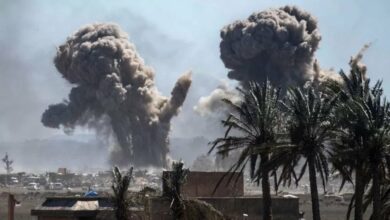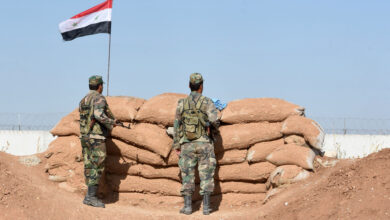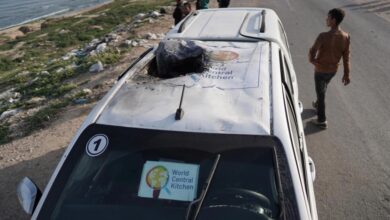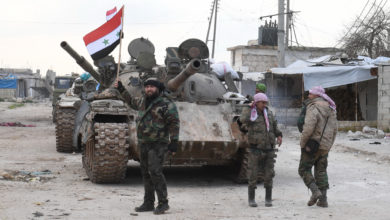‘We need time’: Incredulous US officials hustled to alert ‘shocked’ allies about Trump’s Syria withdrawal
US State and Defense officials scrambled to rework plans after Trump’s decision to withdraw troops from Syria earlier than 'anyone had even contemplated'
ERBIL, Kurdistan Region of Iraq – A sudden decision by U.S. President Donald Trump on Tuesday, December 17 to announce the defeat of ISIS and the imminent withdrawal of U.S. forces from Syria threw the top levels of the State Department into overdrive to mitigate the damage and find a way to buy the military more time.
According to details of conversations between senior officials obtained by The Defense Post, the White House decision to go ahead with the announcement was made without consulting senior State Department personnel with responsibility in the region, and apparently without the knowledge of Lieutenant General Paul LaCamera, commander of Combined Joint Task Force – Operation Inherent Resolve, the U.S. mission against ISIS in Iraq and Syria.
It became apparent in those discussions, which included senior State and key Defense Department officials, that the original plan had been for Trump to announce the defeat of ISIS’s physical caliphate and the first steps towards bringing U.S. troops home during the upcoming State of the Union address, traditionally held in late January or early February.
Working under that assumption, State Department officials believed earlier this week that they had significantly more time to leverage diplomacy towards favorable conditions before the military withdrawal.
Last week, U.S. officials began discussing the planned American withdrawal with Syrian Democratic Forces commander-in-chief General Mazlum Kobane, but had not expected to make a public announcement for some time.
At a Cabinet-level meeting on Tuesday morning, senior administration officials discussed a number of concerns about the proposed withdrawal plan, including how the U.S. might continue to support the SDF, which has come under repeated threats of attack by Turkey recently, and how to ensure the enduring defeat of ISIS without the presence of U.S. forces on the ground.

The Turkish government considers the People’s Protection Units (YPG), a core component of the SDF, to be inextricably linked to the outlawed Kurdistan Workers’ Party (PKK), which has waged a decades-long insurgency in Turkey, and is designated as a terror group by Turkey and its Western allies.
But the YPG is not a proscribed organization in the European Union, United Kingdom or United States, and U.S. defense officials have publicly maintained support for the group.
According to the conversations, the general consensus of Tuesday’s Cabinet-level meeting was that one administration official would try to convince the president to give the drawdown more time.
Hours later that plan was thrown into disarray, as State and Defense officials learned of a withdrawal deadline that was only weeks away, significantly earlier than “anyone had even contemplated,” an official said.
One senior official expressed confusion as to where the new directive had come from.
Word also spread that Trump intended to announce the defeat of ISIS and American withdrawal imminently.
The news sent the top echelons of U.S. foreign policy machine scrambling to formulate a plan to buy more time from the White House.
State Department officials were able to stall the White House announcement until Wednesday, and raced to inform U.S. partners in Syria, senior Turkish officials, and Coalition allies.
“We were hustling to alert people all over the world,” an official said.
State and Defense Department officials did not respond to requests for comment by publication time. U.S. Central Command declined to make LaCamera available for comment.
‘If you hear anything about a time frame, it’s a lie’
Perhaps in a demonstration of the lack of clarity the change in timing caused, the Pentagon on Wednesday referred reporters’ questions to the White House, while White House officials on a later background call with the media redirected those same questions to the Pentagon.
A senior State Department official gave an order to cancel a scheduled press briefing on Wednesday to avoid anyone going on the record.
During the discussions on Wednesday, a senior U.S. military commander revealed that he had received verbal instructions to begin preparations to withdraw from Syria just hours before Trump’s tweet, and that although he had been made aware of the new deadline, he had not received it in writing at that time.

The commander expressed that the new withdrawal deadline was simply not logistically possible, and voiced serious concerns that a failure to properly contain ISIS during a U.S. withdrawal would leave American forces vulnerable.
Seizing on the commander’s points, senior State Department officials, in coordination with the Defense Department, then began to urgently formulate a plan to try to convince “the highest levels of this government” not to commit to a pull-out date by emphasizing the impossibility of doing it safely for U.S. troops.
They insisted on the need for a step-by-step process and stressed that no one should commit to a date for withdrawal.
“We need time to work this. We need to work this with the Kurds, we need to work this with the Turks. We need to work this with the rest of the international community which is in shock right now,” one official said.
“A timeline anything like the one that’s been bandied around would undercut our entire diplomatic effort.”
“If you hear anything about a time frame, it’s a lie,” another participant in the discussions said.
It was not clear at the time of publication whether any agreement to change or nullify the proposed deadline had been reached.
‘ISIS is still strong in the region’
In the statement on Wednesday, White House spokesperson Sarah Huckabee Sanders announced that “the United States has defeated the territorial caliphate,” and that a transition to “next phase” of the campaign had begun.
Just last week, U.S. special envoy for the global coalition to defeat ISIS Brett McGurk said the final ground operations against ISIS near Hajin in eastern Syria could take “months,” and that U.S. forces would remain in Syria after the “physical defeat of the caliphate.”
McGurk said that any other approach would be “reckless.”
Last week, SDF commander-in-chief Mazlum told Reuters that he would be forced to redirect his fighters from the fight against ISIS in Hajin to defend the Turkish border in case of an attack by Ankara. If that happens, Mazlum said, “the battle against Daesh is not possible.”
SDF spokesperson Mustafa Bali on Friday said that ISIS had launched a counter-attack on the town of Hajin, tweeting: “they got high [morale] from U.S. decision to withdraw from Syria.”
“ISIS is still strong in the region,” he added.
from Hajin :
ISIS is launching huge attack, heavy clashes are taking place there.
only 35% percent from Hajin is liberated by our forces.
we think that ISIS will keep launching attacks in the future.
everybody should be aware that #ISIS is still strong pic.twitter.com/kGDZCXA5RG— Mustafa Bali (@mustefa2bali) December 21, 2018
State Department officials on Wednesday were also seriously concerned that an outbreak of fighting between Turkish military forces and the YPG could leave U.S. personnel in the crossfire.
Administration officials agreed on Tuesday to withdraw the U.S. observation posts along the Syria-Turkey border to show Turkey the American withdrawal was legitimate, and to avoid provoking a Turkish attack on northern Syria while U.S. forces are still present.

Late Thursday, U.S. Defense Secretary James Mattis resigned in protest of Trump’s decision to withdraw American forces from Syria, reportedly after a final attempt to change the president’s mind.
“One core belief I have always held is that our strength as a nation is inextricably linked to the strength of our unique and comprehensive system of alliances and partnerships,” Mattis wrote in a letter to Trump released by the Pentagon.
“We must use all the tools of American power to provide for the common defense, including providing effective leadership to our allies,” he wrote. “The Defeat-ISIS coalition of 74 nations is further proof.”
“I don’t want to say it … but today is a good day for Qassem Soleimani,” a top State Department official said during the internal discussions on Wednesday, referring to the head of Iran’s Islamic Revolutionary Guard Corps Quds Force which has fought on the side of Syrian President Bashar al-Assad.
“I’m tired,” another senior official said.
US to leave Syria-Turkey border observation posts in effort to buy withdrawal time












10 Comments